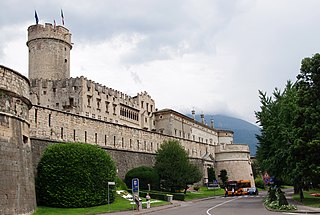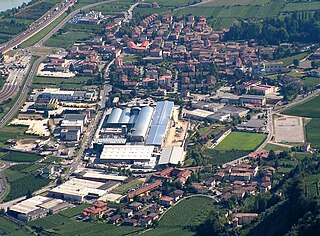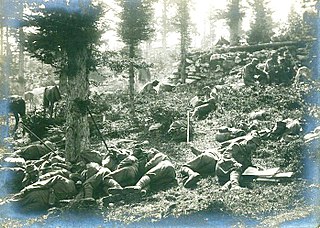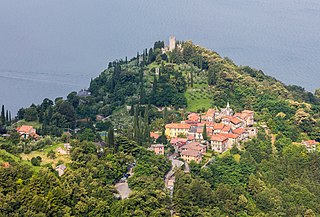
Rovereto is a city and comune in Trentino in northern Italy, located in the Vallagarina valley of the Adige River.

Trentino is an autonomous province of Italy in the country's far north. Trentino and South Tyrol constitute the region of Trentino-Alto Adige/Südtirol, an autonomous region under the constitution. The province is composed of 166 comuni. Its capital is the city of Trento (Trent). The province covers an area of more than 6,000 km2 (2,300 sq mi), with a total population of 541,098 in 2019. Trentino is renowned for its mountains, such as the Dolomites, which are part of the Alps.

Buonconsiglio Castle is a castle in Trento, northern Italy.

Avio is a comune in Trentino in north Italy. It is about 50 kilometres (31 mi) from Trento, in the Vallagarina, and is crossed by the Adige river. Avio occupies a flat plain, bounded by the Monte Baldo from east and by the Monti Lessini from west.

Pomarolo is a comune (municipality) in Trentino located around 15 kilometres (9 mi) southwest of Trento in the northern Italian region of Trentino-Alto Adige/Südtirol.

Villa Lagarina is a comune (municipality) in Trentino, northern Italy, located about 20 kilometres (12 mi) southwest of Trento.
Eccellenza Trentino-Alto Adige/Südtirol is the regional Eccellenza football division for clubs in the northern Italian region of Trentino-Alto Adige/Südtirol, Italy. It is competed amongst 16 teams, in one group. The winners of the Groups are promoted to Serie D. The club who finishes second also have the chance to gain promotion, they are entered into a national play-off which consists of two rounds.

The Giardino Botanico Alpino di Passo Coe is a municipal nature preserve and alpine botanical garden located at an elevation of 1612 meters on Monte Marònia in Passo Coe, about 5 km southeast of Folgaria, Trentino, Italy. It is managed by the Museo Civico Rovereto, and open Tuesdays through Sundays in the warmer months.

The Etschtal, Italian: Val d'Adige or Valle dell'Adige, is the name given to a part of alpine valley of the Adige in Trentino-Alto Adige, Italy, which stretches from Merano to Bolzano and from Salorno to Rovereto.

Lagarina Valley is a valley in northern Italy, used to define the lower mountain course of the Adige River. It is mostly included in the province of Trentino, with the lower section being part of the province of Verona. The largest town is Rovereto.

The Castle of Avio is a medieval castle in the comune Avio, Trentino, northern Italy. It is currently held by the Fondo per l'Ambiente Italiano (FAI). It is one of the several castles commanding the Vallagarina valley of the Adige River. It features several rooms with medieval frescoes.

Castello di Vezio is a castle located nearby Varenna and Perledo, northern Italy. Characterized in the main tower by square merlons, similar to Cly Castle in Aosta Valley, it commands the Lake Como. It was once connected by walls to the village of Varenna below.

The Cross della Vallagarina is an annual cross country running competition that is held in mid-January in Rovereto, Italy. The competition derives its name from the Vallagarina valley in which the city is located. It was first held in 1978 following the success of local runner Cristina Tomasini at the 1977 IAAF World Cross Country Championships. She was the inaugural winner of the Cross della Vallagarina, which was unusual in being a women's competition only – the men's race was added later in 1981.

Palazzo delle Albere is a Renaissance villa-fortress in Trento, northern Italy. It was built during the 16th century by the Madruzzo family of prince-bishops of Trento. It takes its name from the rows of poplars that once led to the castle; it is surrounded by a park, now smaller than once because it is crossed by the Brenner Railway and partly occupied by the Trento Monumental Cemetery. It has a square plan, with four square, 6 m-wide and 20 m tall corner towers, surrounded by a ditch.

Arco Castle is a ruined castle located on a prominent spur high above Arco and the Sarca Valley in Trentino, northern Italy.

In the 1800s, when the Austro-Hungarian Empire controlled the territories of the upper Adige valley in northern Italy, a tobacco plant was built in the town of Borgo Sacco, now part of the city of Rovereto. An earlier name for this tobacco factory was Imperia Regia Manifattura d'Austria-Ungheria.

Vallagarina is one of the sixteen districts of Trentino in the Italian region of Trentino-Alto Adige/Südtirol. Its administrative seat and major town is Rovereto.

Alta Valsugana e Bersntol is one of the sixteen districts of Trentino in the Italian region of Trentino-Alto Adige/Südtirol. Its administrative seat and major town is Pergine Valsugana.
The Artillone hut is one of the mountain pastures located on Monte Baldo, in the municipality of Avio, in the autonomous province of Trento, Italy. It is called Bubeskopf in Germany.
















